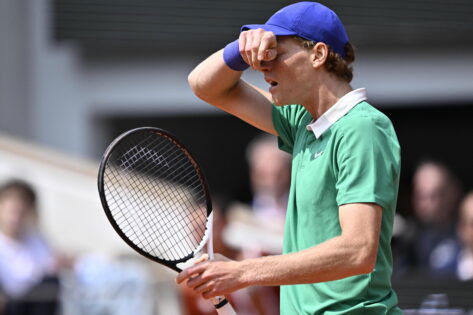If you’ve followed tennis even loosely, the chaos is impossible to ignore: midnight finishes, brutal turnarounds, and players stretched beyond reason. The sport stands at a crossroads, reshaped by sweeping structural changes. This summer, the National Bank Open and Cincinnati Open unveiled their 12-day Masters format, a bold, historic shift, but one that dragged scheduling into a full-blown crisis. Matches bled deep into the night, fatigue ran wild, and questions about player welfare thundered louder than ever. And now, as frustration spills across the tour, the ATP president has finally broken his silence on the storm engulfing the game.
Recently, ATP president Andrea Gaudenzi opened up about the storm surrounding tennis scheduling in a candid interview with Bola Amarela. With criticism mounting over the expanded Masters format, Gaudenzi admitted the challenge but doubled down on the bigger picture. “The 12-day tournaments add about 15 extra days to the annual calendar, but also allow the reinjection of capital into the sport. It’s up to the players to adjust their schedules, even if it means forgoing smaller tournaments or appearance fees.” He reminded players that, unlike many sports, tennis offers freedom of choice, but with that freedom comes responsibility.
Yet, the backlash from the locker room has been sharp and unrelenting. The Canadian Open and Cincinnati Open, now extended to 12 days, have shattered the familiar Monday-to-Sunday rhythm.
Italiano foca preocupação nos torneios maiores e não demonstra grande ‘afeto’ pelos 250 e 500.
“Cabe aos jogadores ajustarem as suas agendas, mesmo que isso implique abdicar de torneios menores ou de ‘appearance fees”…https://t.co/ZrY2u0bHBu
— Bola Amarela (@Bola_Amarela) August 18, 2025
The Toronto final was played on a Thursday, and Cincinnati’s title clash is set for a Monday, an unfamiliar stretch that has left players both bewildered and exhausted. While some hail the move as a chance for lower-ranked hopefuls to shine, others, especially the top stars, are far from convinced.
World No. 1 Jannik Sinner has been among the most vocal, raising his hand against the new format. Standing firm, the Italian has voiced his preference for the traditional one-week Masters events, praising Monte Carlo as a perfect example. “My personal view…I love the one-week events. I love it when you see that the tournament in Monaco, for example, you have for Monte Carlo, you have this one-week event, and you have the first-round matches, which are incredibly good,” Sinner said, painting a vivid picture of tennis’ lost rhythm.
The Italian star argued that the condensed format preserved excitement and structure: fans could buy tickets knowing they’d witness a quarterfinal on Friday, a semifinal on Saturday, and a final on Sunday. Instead, the new system blurs those lines, testing patience and endurance on both sides of the net. “It’s a question that’s quite irrelevant now to answer because we are in that position,” Sinner admitted, but his tone reflected the discontent simmering across the ATP ranks.
And it wasn’t just Sinner who lit the fire. During the Canadian Masters, Alejandro Davidovich Fokina took his frustration to X, penning a scathing bilingual message. He began politely, “Good afternoon,” before unleashing on the scheduling chaos. “Tomorrow, every match starts at 12:30, except ours, which has been scheduled at 11:00. We’re staying one hour away from the club, which means we have to wake up extremely early to arrive in good condition.” His words cut deep, spotlighting the very real strain of unpredictable timetables.
But make no mistake, this storm doesn’t end with the ATP. The WTA side has felt the same whip of erratic scheduling, players stumbling into late-night finishes and punishing turnarounds. The outcry is growing, and while Gaudenzi insists the vision is long-term, the present reality feels brutal.
The game may be reinventing itself for the future, but for the players on court today, the question hangs heavy: at what cost?
Anna Kalinskaya voices frustration over brutal scheduling
Anna Kalinskaya’s rise in recent weeks has been nothing short of electric. At the Citi Open, she dazzled her way to the final, only falling short against Canada’s Leylah Fernandez. Carrying that fire into Cincinnati, the Russian carved her path into the quarterfinals before being stopped by Iga Swiatek. Yet, beyond the wins and losses, her biggest battle came not against her rivals but against the clock.
Her frustration boiled over when scheduling robbed her of recovery. After a grinding round of 16 victory over Ekaterina Alexandrova, she revealed she reached home at 2:40 am, asleep only by 4 am. Hours later, she was staring at an 11 am clash with the world’s best.
“How can the WTA and tournament expect athletes to perform their best when the scheduling is this unfair?” she asked on Instagram. The truth in her words stung, painting a picture of exhaustion hidden behind the scoreboard. Kalinskaya added, “Seems a bit one-sided,” calling out a system that seemed to forget the human side of the sport.
Her voice joins a growing chorus. From Jannik Sinner voicing his preference for one-week events to Alejandro Davidovich Fokina blasting chaotic schedules in Canada, both ATP and WTA stars are now speaking louder than ever. The toll is real, the frustration undeniable.
With ATP President Andrea Gaudenzi already defending his long-term vision, the clash between ambition and athlete welfare intensifies. Tennis may be evolving, but until the sport reconciles commercial expansion with human limits, these scheduling storms will keep raging. The question remains: how long can the players bend before something breaks?
The post ATP President Finally Breaks Silence on Scheduling Crunch Over Jannik Sinner and Others’ Uproar: ‘Up to the Players’ appeared first on EssentiallySports.
